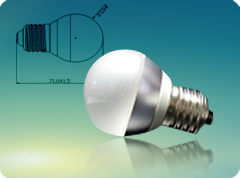Few months a brighter and cheaper LED lighting bulb comes out, and all of our lighting products become brighter and less expensive just by changing part numbers. Indeed you can simply plan on this being true. But this comes with a downside too.
For one thing, probably we've designed with enough LED lighting bulbs to obtain the required brightness in the first place. If we now substitute brighter LED bulbs, perhaps the light will be too bright. In a traditional engineering environment, this would be viewed as a cost-cutting opportunity. We can now make a new design that uses fewer LED lighting. We can reduce the cost of the heat sink, and the ballast can be redesigned to produce less power. Unfortunately, all of this takes time and engineering resource. Redesign of the ballast can take a couple of weeks. The analyses have to be redone. All the tests have to be run again: thermal, EMI, and aging. Maybe UL qualification has to be redone. But before this new design is implemented, the next new LED lighting bulb will be out.
While this may sound like assured employment for the engineering department, the reality is different. Management may decide to skip a generation to get adequate return on the engineering expenses already incurred, or you may have inventory that has to be used up before the next design can be produced.
The right way to deal with these problems is to plan for obsolescence. That is to say, if your design needs 18 LED lights, it isn't too hard to figure out that in the near future it will only need 16, and not too far down the road it will only need 12. That way you don't have to redesign the ballast, and you will save time and money.
Product List
- LED Light Bulb
- LED Tube Light
- LED Spot Light
- LED Strip
- LED Down Lights
- LED Bay Lights
- LED Panel Light
- LED Module
- COB LED Light
- Rechargeable LED Lights
- LED Sensor Light
- LED Christmas Lights
- Power Supply
- LED Flood Light
Latest News
- The LED Tube Light Fixture - Answer to Those High Bills
- Installing LED Spotlight Bulb Outdoor to Get Benefits Now
- LED Striplight for Cars-Upgrade the Look of Your Vehicle
- The Best LED Light Bulb Review For Customers
- Four Factors of LED Light Technology Development Trend
- Buy Dimmable LED Light Bulbs Save Your Energy and Money
- The Growth of LED Light Industry India
- LED Streetlight Cost Saving Examination
Contact Us
(86) 372 5081976
sale@chineselight.com
FAQ





